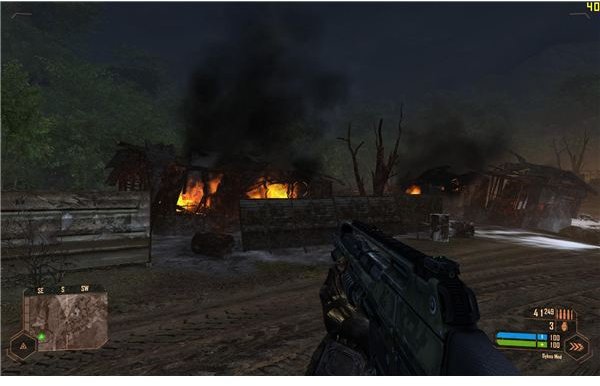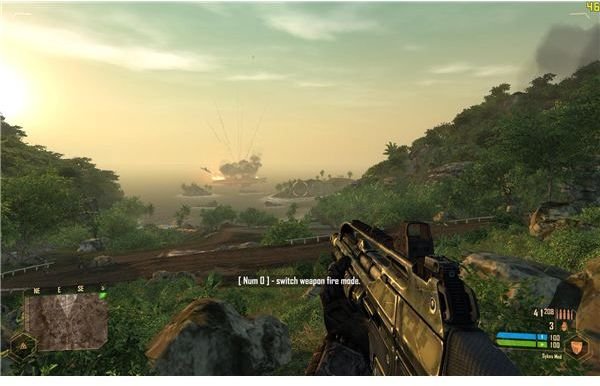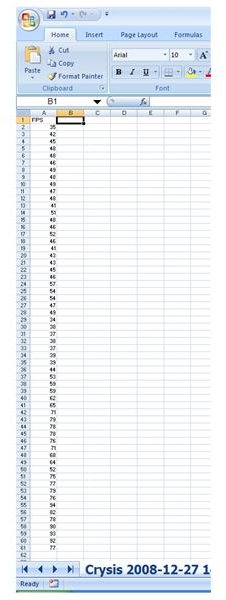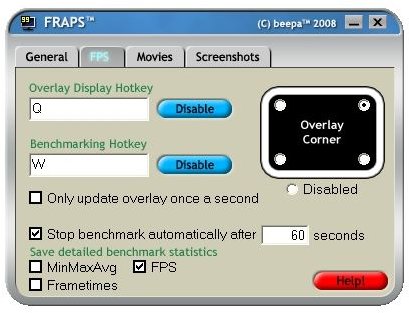How to Create a Customized Real World Video Card Benchmark Using Fraps
Fraps from Beepa Software allows a user to display frames-per-second, take screenshots and videos, and conduct real-world benchmarking all during full-screen Windows gaming. Fraps may be used whenever a full-screen DirectX or Open GL game is running. This is particularly useful when a video game will not allow the gamer to return temporarily to the desktop to start or stop such services. Using hotkeys, Fraps allows all of these functions at the touch of a button without interruption of gameplay.
Fraps Benchmarking Example




Benchmarking with Fraps: A Basic Example
Before beginning any benchmark, a key must be setup in Fraps that will begin and end the benchmarking utility. On the Frames per Second (fps) tab the user must assign a benchmarking hotkey. This hotkey may be any of the keys found on the standard Windows keyboard but it is advised that the user be certain no other function both in the game and in Windows, is assigned to this key. Good candidates include the “scroll lock”, “pause”, and any of the upper F-keys (F9 through F12) as these are usually not assigned to other functions. In the screenshot of Fraps above, I have arbitrarily assigned the “w” key as the benchmarking hotkey.
For this basic example, I have decided to capture just 60 seconds of gameplay data so I have checked the “stop benchmark automatically after” checkbox and I have assigned a value of 60 seconds to this option. I have also checked the “FPS” option under the three detailed benchmark statistics options available at the bottom of the Fraps window.
I have decided to run a benchmark while playing Crysis Warhead, a recently-released first-person shooter from Crytek that is generally known to excessively tax a gamer’s computer. When I am ready to start the benchmark in-game, I will hit the “w” hotkey and continue playing as usual while Fraps gathers the data automatically. I am playing with the following general video settings:
Resolution: 1680x1050
Anti-aliasing: Off
Fullscreen: On
Vsync: Off
Video Settings: Mainstream (synonymous with medium settings)
It is beyond the scope of this article to discuss the meaning of all these settings. I normally play the single-player portion of Crysis Warhead at these settings. I chose a particularly high-poly count area of the first mission in the game. After running the benchmark, the results can be found in the “c:/Programs Files/Fraps/benchmarks” directory or wherever the user has installed fraps. The resulting file can be opened in a spreadsheet for viewing and further analysis.
The results from this example test show that the maximum fps I got was 94 and the minimum was 34. This reveals that under the settings stated above, my computer is generating enough fps to allow smooth gameplay under resource-taxing conditions in Crysis Warhead. Had the results shown an inadequate minimum fps, I could lower the in-game video settings and run another benchmark. In addition, since the raw data may be opened in a spreadsheet, further statistics such as mean, median, mode, geometric mean, standard deviation, etc. could easily be calculated and used to create a custom benchmarking profile.
Conclusion
The benchmarking function in Fraps is so easy to use that even new users can begin using it right away to test their computers while running any full-screen Windows game. Results presented in a spreadsheet allow for an unlimited number of custom calculations or even just a cursory look at the raw data to determine system performance. Certainly, the example presented here is simple. The next article in this series builds on this example to show the real power of custom benchmarking using Fraps. However, this article forms the basis for all benchmarking using the utility.
This post is part of the series: Benchmarking a Computer’s Video Capability Using Fraps
Fraps from Beepa Software allows gamers to benchmark their computers with various configurations and settings. In doing so, gamers can determine their current computer’s capabilities and check to see if an upgrade is warranted.
